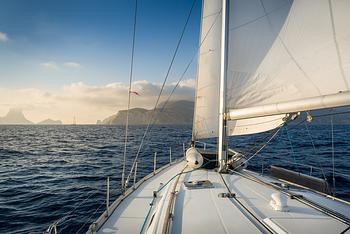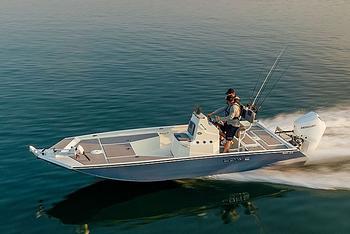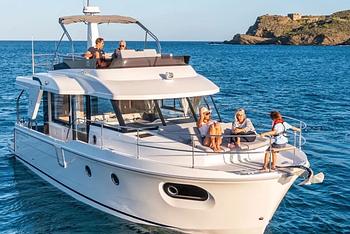Every summer, the country’s lakes come alive with all manner of craft. From the Great Lakes to the Ozarks, inland waters offer calm conditions, plenty of adventure, and a buzzing social scene. Whether you prefer to venture to off-the-beaten-track destinations for a spot of quiet fishing or back-to-nature adventure, or enjoy the excitement of watersports and shoreside amenities then there’s a space for you. The type of boat you choose to buy will depend very much on your choice of activity, and the choices are as varied as the lakes themselves. So here we take a look at some of the most popular types of lake boats and what they can offer.

Pontoon Boats
The trusty float boat is a common feature on the lakes in summer. With lots of space for large families and groups of friends thanks to their flat layout, they come in sizes ranging from 16 feet to over 25 feet, with prices starting from $7,000. You’ll find them with waterslides coming off the side, stand-up bars, sun pads, BBQs and expansive lounge areas, and they’re popular choices for those who enjoy fishing and watersports. While the pontoon boat was never thought of as particularly sexy, a whole new breed of ultra-fast, ultra-sleek pontoon boat is whizzing across the inland waterways that are very James Bond. The choice of pontoon boats are simply huge, from budget options such as the lightweight Bennington S 188 SL up to the luxury 34-foot Premier Escalante with two enormous 425-hp outboards on the back and a waterslide curling down from a second story deck.
Quick Facts
- Main activities: Cruising, family fun, entertaining
- Top brands: Bennington, Godfrey, Avalon, Lowe Boats, Starcraft, Sylvan, Sun Tracker, Tahoe, Manitou, Barletta, Princecraft, Crest, Sea-Doo
- Capacity: 8 - 15 passengers (some can accommodate up to 20)
- Approx. price range: $10,000 to $250,000
- Skill level: Beginner to intermediate
Pros:
- Lots of interior and deck space which allows not only for more passengers than other boats of the same size, but also for entertaining, swimming, fishing, and comfortable cruising.
- Very stable in the water and easy to handle—ideal first-timer boats or for those looking for simple lake fun. While pontoons were once seen as slow float boats, today they have powerful engines and can be used for a wide variety of uses including fishing and watersports.
Cons:
- Not as fast or efficient as a boat with a planing hull and also won’t handle rough water as well. Pontoons tend to be used on inland waters and lakes because of these attributes and are used in fair weather conditions, especially as most don’t have any cover.
- Can be more difficult to load onto a trailer and tow because of the wide draft and bulky design.

Deck Boats
Deck boats are defined by their spacious decks for their size and are practical family runabout boats, often compared to bowriders. They usually have a V-shaped hull and range from 12 to 30 feet in length. On lakes, these are becoming increasingly popular as they offer the elegance of a day cruiser with lightweight portability. For those who want to get out on the water for a day of socializing, deck boats can accommodate up to 14 passengers in comfort, but they also have great fishing attributes too. The range is extensive, with prices for boats such as the Starcraft Marine Limited IO 2000 around $27,000, while larger models such as the Stingray 212SC Deck Boat offers everything from stereo systems to changing rooms and sells for around $45,000. See the article deck boat vs pontoon boat.
Quick Facts
- Main activities: Cruising, sunbathing, swimming, fishing, watersports, family fun.
- Top brands: Sea Ray, Bayliner, Starcraft, Hurricane, Princecraft, Tahoe, Crownline, Stingray, Yamaha, Chaparral, Four Winns, Regal, Cobalt, Chris Craft.
- Capacity: 10 – 14 passengers
- Approx. price range: $20,000 to $150,000
- Skill level: Beginner to intermediate
Pros:
- Their lighter weight makes them ideal for beach trips, family fishing, and simple watersports. They are extremely versatile and can be adapted to suit a wide variety of activities and are easy to handle and maintain.
- Easy to tow and launch making them a good option for those who like to travel and explore different boating regions.
- There are many options available so they can fit into most budgets. There is huge competition within this sector so it’s possible to find a model to suit your needs and budget, whether that’s new or second hand.
Cons:
- They are not designed for rough waters and are therefore better suited to inland waters and mild weather conditions.
- They aren’t the easiest type of boat to board. They are therefore often not the best choice for those with reduced mobility or young children.
- Due to their small size they may have small fuel tanks and can’t be used for long trips. They are well-suited to day trips on the lakes.

Photo credit: Sea Ray
Jon Boats
Jon boats are rough, rugged, seemingly indestructible and downright All-American. These slim-line, flat-bottomed utility vessels favored across the US as the perfect, robust fishing boat. They come in a variety of shapes and sizes, from simple small models such as the 10-foot Lund 1040 starting around $1200, which have nothing more than room for you and some fishing gear, to larger models such as the 18-foot center-console Roughneck 1860 by Lowe Boats starting at $27,000 equipped with an impressive range of accessories—we’re talking casting decks, swivel seats and livewells. Find more on our guide about the best jon boat brands.
Quick Facts
- Main activities: Fishing, hunting, watersports
- Top brands: Lowe, Lund, Tracker, Triton, Crest, Alumacraft, Carolina Skiff, SeaArk
- Capacity: Up to five passengers
- General price range: $1,200 - $25,000
- Skill level: Beginner to intermediate
Pros:
- Can be used in shallow lake areas thanks to very shallow drafts. This allows for close access to fishing and hunting grounds.
- Well-equipped for fishing with a range of accessories such as swivel chairs, casting decks, rod holders, and livewells.
- Easy to trailer, tow and store thanks to their compact size and lightweight materials. Smaller models can even be put on the roof of an SUV.
Cons:
- They don’t offer any shelter and so tend to be used in fair weather or in combination with appropriate wet weather gear.
- Not suited to rough waters because of their shallow draft. Jon boats are used on sheltered inland waters.

Photo credit: Lowe Boats
Fishing Boats
Practical and sturdy, fishing boats are designed with all things fishing in mind, from their seat configurations to their livewells, trolling motor, rod holders and accessories. They tend to have a V-shaped hull and high sides, with enough deck space to reel in your catch. The choice of freshwater fishing boats on the market is simply enormous, from simple entry level fishing boats such as the Carolina Skiff 17LS starting at around $35000, to Boston Whaler’s stunning flagship 420 Outrage that retails for over $1 million. Check out our guide: Best small fishing boat brands.
Quick Facts
- Main activities: Fishing, cruising, watersports
- Top brands: Alumacraft, Crestliner, Lund, Ranger, Triton, Lowe, Boston Whaler, Grady-White, Freeman Boatworks, Contender, EvergladesTracker, Skeeter.
- Capacity: 2 – 12 depending on the size and style of the fishing boat
- General price range: $10,000 to $200,000
- Skill level: Beginner to Intermediate
Pros:
- They can be used for different activities such as day cruising and some watersports depending on the accessories and style of fishing boat. While there are some tournament-level fishing boat models out there, some are designed to be more versatile and accommodate watersports and family comforts.
- Many smaller models can be towed and launched with ease, although this doesn’t apply to larger sportfishing yachts.
Cons:
- They are geared around fishing, so have fewer sun lounging areas than similar-sized motorboats. Wraparound deck spaces are used for casting and reeling and there are fewer seating areas or accessories.
- Storage areas are taken up with livewells, coolers and other fishing accessories meaning less space for water toys or entertaining items.

Photo credit: Boston Whaler
Watersports Boats
As the name implies watersports boats (also known as tow boats) are designed to tow waterskis and wakeboards with their powerful engines. While they’re predominantly focused on watersports they are also popular for fishing and as day boats on the lakes. Characteristics tend to include good visibility of the skier/wakeboarder from the helm, an inboard engine, and plenty of storage space for skis, wakeboards and equipment. Boats tend to be activity-specific, with slalom skiers looking for small wakes, while wakeboard riders and wakesurfers wanting big ones for example. They vary hugely in size from smaller models such as the ultra-speedy, compact MasterCraft NXT 20 which can seat 14 people, to larger models such as the popular Malibu M Series M235.
Quick Facts
- Main activities: Watersports, cruising
- Top brands: ATX Surf Boats, Axis Wake, Centurion, Chaparral, Malibu, Mastercraft, Tige, Moomba, Supra
- Capacity: 6 – 16 depending on the size and style of the boat
- Approx. price range: $100,000 to $250,000 depending on the style, size, and accessories.
- Skill level: Intermediate to advanced
Pros:
- Watersports boats offer high speeds and excellent maneuverability, as well as the ability to trim the wake for very technical-sized wakes. They are equipped with all the accessories you need for towing and storing equipment.
- They have plenty of seating for their size (often in the bow) and accommodate more passengers than comparable sized boats.
Cons:
- They can be limited in their use as they are very activity-specific. With everything geared towards watersports, these compact boats don’t have many of the comforts and accessories that other boats of a similar price would have.
- They are expensive for their size. Because of how technical these boats are, with state-of-the-art engineering and the ability to create perfect wakes, they are more expensive than most other boats of the same size.
Photo credit: MasterCraft
Cabin Cruisers
The perfect weekend or overnight boat, cabin cruisers are wonderfully versatile and allow you to sleep, cook, lounge on deck, enjoy some simple watersports, and entertain friends. At their most simple a cabin cruiser is just that, a motorboat with a cabin, but the more budget you have the more luxury and space you get. At the top end of the market, luxury cabin cruisers are reminiscent of mini superyachts. The Grady-White Marlin 300 is a great example of a compact cabin cruiser. At 30 feet it is a good all-rounder, offering a walk-around deck that is perfect for fishing, as well as a cozy cabin, compact galley and head. At the other end of the spectrum, models such as Grand Banks GB54 offer a beautiful, spacious interior, with huge deck spaces and comfortable seating. Check out our guide: Types of boats with cabins
Quick Facts
- Main activities: Cruising, entertaining, family fun, overnight trips
- Top brands: Jeanneau, Quicksilver, Sea Ray, Boston Whaler, Axopar, Beneteau, Bayliner, Crownline
- Capacity: 8 passengers on average
- General price range: $20,000 to $2 million-plus, depending on size and level of luxury.
- Skill level: Intermediate
Pros:
- Many larger cabin cruisers offer the luxury of a superyacht with a smaller price tag. From luxury cabins to galleys, saloons, cockpits, and lounging spaces they offer the comforts of home for weekend trips away.
- They are versatile and easy to handle making them popular with families. With bow thrusters and plenty of storage they bring convenience, peace of mind, and comfort to motor cruising.
- They are packed with home comforts such as lounges, fully-equipped galleys, shower rooms, and swim platforms to name just a few.
Cons:
- Cabin cruisers can have a high fuel consumption for their size due to their weight. This is something that needs to be taken into consideration when calculating the running costs of a boat and how far you plan to travel and how frequently.
- Only the smallest models can be put on a trailer, so all other models will require a full-time mooring and the annual costs that this involves will need to be factored in.

Photo credit: Cutwater
Bowriders
As one of the most popular boats bought in the US every year, the bowrider is identified by its V-shaped seating section in the bow. Using sterndrive or outboard engines, they range from 17ft to 35ft and usually hold between six and ten people. The design is well-suited for recreational watersports such as water skiing, tubing and swimming. The pocket 15 feet Bayliner M15 is the perfect example of a lightweight, simple to handle bowrider which promises fun days on the lakes, while the Monterey 305 Super Sport packs a punch with 500 horsepower engines, luxurious seating and a head. Check out our guide: Best bowrider boat brands for every boater.
Quick Facts
- Main activities: Cruising, entertaining, family fun, watersports,
- Top brands: Monterey, Bayliner, Sea Ray, Boston Whaler, Chaparral, Cobalt, ATX Boats, Four Winns, Scarab, Tahoe, Vanquish
- Capacity: 6 to 10 passengers on average
- General price range: $20,000 to $500,000 although some can cost considerably more
- Skill level: Beginner to intermediate
Pros:
- Bowriders are well-suited for recreational watersports, allowing families to enjoy a variety of tow sports for much less than the price of a dedicated watersports boat.
- They offer unobstructed views from the bow seating which is good for watersports, watching children swimming, and general safety.
- They are renowned for being easy to handle and maneuver making them popular choices for families or those buying their first boat.
Cons:
- Smaller bowriders are not ideal for use in inclement weather conditions as they can create an uncomfortable ride. These are better fair weather boats as many don’t offer much in the way of shelter either.
- Bowriders are designed for maximizing passenger capacity and therefore they forfeit storage space for seating. As such there is limited storage for food, drinks, fishing gear, or watersports equipment.
- Most bowriders tend to be fairly simple in their set up and offer few facilities compared to cabin cruisers. This makes them best for short outings on the lake.

Photo credit: Bayliner
RIBs and Inflatables
RIBs (rigid inflatable boats) are the perfect towing boat and can vary in size from tiny, budget-friendly two person boats with a small outboard on the back, to ultra-luxurious, high speed Maxi RIBs with cabins and a whole host of amenities. You can pick up a small, simple RIB such as a 10-foot Zodiac Cadet Aero fully inflatable boat for as little as $1000, or at the other end of the price spectrum are Maxi RIBs such as the 47-foot Rebel 47 by SACS Marine, which costs around $1 million, but a mid-range 23-26 feet used model will be in the $50,000 -$75,000 range. RIBs of all sizes and shapes are renowned for their hardiness and make for versatile and fun lake boats.
Quick Facts
- Main activities: Cruising, entertaining, family fun, watersports
- Top brands: Zodiac, Zar Formenti, Technohull, Ribcraft, Airship, BRIG, Scorpion, Humber, Ribeye, Williams Tenders.
- Capacity: 2 to 14 passengers depending on the size.
- Approx. price range: $1,000 to $75,000 although some can cost considerably more
- Skill level: Beginner to intermediate
Pros:
- RIBs are built from strong, durable materials such as Hypalon or PVC for the tubes and glass-reinforced plastic (GRP) for the hulls making them robust and safe boats.
- They can be budget-friendly, especially smaller models with smaller engines. While there are some high-end large, luxury models, for the most part RIBs can be bought fairly inexpensively and are popular tenders.
- They are easy to load onto a trailer and tow thanks to their lightweight properties. They are one of the most popular types of lake boats to trailer because of this.
Cons:
- RIBs tend to have less seating than sports boats as the deck area is comparatively small. This is because the tubes take up a lot of space.
- RIBs don’t have features such as rear swim platforms because of their design with protruding inflatable tubes and outboard engine.

Personal watercraft
Personal watercraft buzz across the lakes all season long and are a standard craft to see on most lakes. They are generally defined as recreational watercraft that the rider sits or stands on rather than rides inside like they would a boat. The most popular personal watercraft are Jet Skis and water scooters, and these can range from entry level Jet Skis such as the Sea-Doo GTI 130 costing around $10,000, up to high-powered watercraft such as the Kawasaki Jet Ski® Ultra 310 series costing over $22,000. The appeal with personal watercraft is how easy they are to transport, as they can be transported on a simple trailer and stored in your yard.
Quick Facts
- Main activities: Adrenaline sport, family fun
- Top brands: Kawasaki, Yamaha, Sea-Doo, Honda
- Capacity: 1 to 3 passengers
- General price range: $5,000 to $20,000
- Skill level: Beginner
Pros:
- Personal watercraft are generally easy to maneuver and handle. They make good beginner crafts and allow novices to learn the rules of the water, basic handling, and mooring.
- They provide lots of high adrenaline fun that the whole family can enjoy.
- Personal watercraft are easy to trailer thanks to their compact size. Many can fit on the bed of a pick up truck making them even more practical.
Cons:
- Personal watercraft can only accommodate one or two people at a time (larger models can seat three) so they are not ideal for a whole family or larger group to enjoy at the same time.
- It is usual to get a lot of spray from a high-adrenaline personal watercraft and therefore they tend to be used in warm weather only.
- Maintenance costs can be higher than some other compact power boats as they have high powered engines. v

Sailboats
No list of different types of lake boats would be complete without sailboats. Sailing is one of the great pleasures of being on the water, and this category offers the greatest variation, from tiny bathtub-sized sailing dinghies, to beautiful sailing yachts and much in between. Sailboats can cost as little as a few hundred dollars to hundreds of thousands of dollars, and be as simple as a sail and rudder to luxurious away-from-home cruisers. Check out our guide to Different Types of Sailboats.
Quick Facts
- Main activities: Cruising, family fun, learning to sail
- Top brands:
- Capacity: 2 to 12 passengers
- Approx price range: $300 to $300,000
- Skill level: Beginner to advanced
Pros:
- Sailboats on lakes offer fun, adventurous and back-to-basics sailing. They are a great way for families to learn new skills together and understand weather and sea patterns and navigation.
- Sailboats are generally cost effective to run as they use the power of the wind and minimal fuel. When used on lakes on breezy days these are very economical boats.
- Again, as they use little fuel, sailboats are environmentally friendly and don’t pollute either the air or water. Many inland waters favor sailboats for this reason.
Cons:
- Except for multihull versions, sailboats usually have deep drafts to keep them upright when sailing which can be limiting on lakes as they must remain in appropriately deep sections.
- Unlike some simple motorboats, sailboats require some training and experience to learn how to operate them safely. From rigs to sail plans there is a lot to learn and it is advised to start off on a smaller, simple sailboat,
- Sailboats are more physically demanding to operate than a motorboat and may require a certain degree of fitness and mobility.

Houseboats
Powered houseboats are self-propelled residential vessels that come in many guises. While some will be limited in the distance they can travel and be more reminiscent of static houseboats, others have plenty of cruising power and are ready for adventures. With a squarer silhouette, powered houseboats can accommodate an impressive amount of living space for their length and offer big windows, and all the amenities and home comforts you want. From the American Houseboat ‘The Zion’, which resembles a true floating house with two bedrooms and a full kitchen, to the Bravada Yachts Atlas V-Series which resemble a sleek superyacht, designers have unleashed their creativity when it comes to houseboats. Check out our guide: The best boats to live on full time
Quick Facts
- Main activities: Living on board
- Top brands: Bluefield, Campi, CaraCat, CatMarina, Lamare, Nautilus, Nordic, Relax Boat, Solar, V Marine
- Capacity: 4 to 12 passengers
- General price range: $25,000 to over $2 million
- Skill level: Beginner
Pros:
- Houseboats offer a huge amount of interior space with all the comforts of a home to facilitate long-term living. They are designed for livability rather than cruising.
- They have creative interior design styles, with full kitchens, lounge spaces, storage, staircases and more making them look more like homes than boats.
Cons:
- With an emphasis placed on comfort and liveability, houseboats have low cruising speeds and can only traverse calm waters. Some aren’t designed to be motored and can only be towed from one mooring to another.
- Because of their larger size it can mean finding a berth is more difficult and costly than for a motor boat.

This article was published in February 2023 and updated in December 2024.




